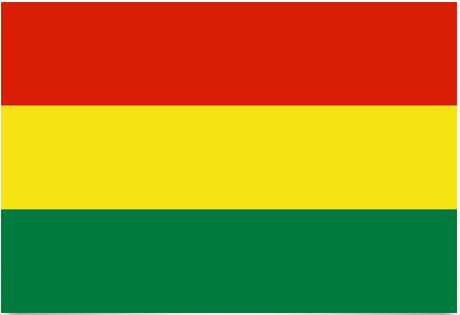Bolivia Flag and Meaning
Flag of Bolivia

Bolivia Flag Meaning
Bolivia’s flag consists of three horizontal ribbons in the colors red, yellow and green. The upper red ribbon symbolizes the struggle for freedom, the yellow in the middle stands for the country’s mineral deposits and the lower green stands for nature. Bolivia became independent in 1825 but that was not when their current flag was decided but then the colors were yellow, green, red from above, this was the same as the flag of Lithuania.
The flag received its current appearance by a decree of President Manuesl Isidoru Belzu on November 5, 1851. The proportions of both the civilian and state flags are 15:22. Like several other South American countries, the civilian flag lacks the nation’s coat of arms, but it is on the state flag.
Bolivia Overview
| Population | 8.3 million |
| Currency | Bolivianos |
| Area | 1,098,580 km² |
| Capital city | La Paz |
| Population density | 7.5 residents/km² |
| HDI location | 95 |
Bolivia – the land without coasts – consists of 3 natural regions. Altiplano (high plateau) with an average height of 4,000 meters above sea level is dry and cold. The majority of the population lives here. Here are the country’s mineral riches: tin, gold, silver, zinc, lead, tungsten and copper. “Yungas” and the valleys on the eastern side of the Andes mountain range have a subtropical climate. Coffee, cocoa, sugar cane, soya, coca leaves and bananas are mainly produced here. In the flat tropical lowland areas to the north and east, the landscape is predominantly forest and savanna. Cattle farming is widespread and rice, soy and sugar cane are grown. There is also oil in the subsoil. Bolivia is territorially divided into 3 valleys that open into Lake Titicaca, the Amazon River and the La Plata River. The unrestrained and uncoordinated exploitation of forest resources is a threat to forests, fauna and water resources.
Over the last hundred years, most of the land that was formerly Native American joint ownership has been cut up and sold to landlords who are either Creole or Mastrites. The Native American majority has thus been displaced to the most remote and least fertile areas of altiplano. The Native American majority is forced to nourish to the best of its ability. First and foremost by primitive farming and animal husbandry for own consumption.
The people: Bolivians are predominantly from the Quechua and Aymará people (57%). About 25% are «mestizer» (a mixture of Europeans and Native people), and there is also a small minority of European descent. They form the ruling class. In the eastern part of the country there is finally the tupí-guaraní people.
Religion: Predominantly Catholic. There is religious freedom.
Language: Spanish (official). More than half of the population also speaks their own languages - quechua, aymará. There are a total of 33 linguistic ethnic groups.
Political parties: The parties with parliamentary representation are as follows: Acción Democrática Nacionalista (ADN, Nationalist Democratic Action) led by General Hugo Banzer; Movimiento Nacionalista Revolucionario (MNR, Revolutionary Nationalist Movement) led by ex-president Gonzalo Sánchez de Losada; Conciencia de Patria (CONDEPA, Conscience of the Fatherland) led by Remedios Loza; Unión Cívica Solidaria (UCS, Civil Civic Union) led by Ivo Kuljis; Movimiento Bolivia Libre (MBL, Movement Free Bolivia); Agrupación Socialista Democrática (ASD, Democratic Socialist Collection); Movimiento Izquierda Revolucionaria (MIR, The Revolutionary Left Movement) led by ex-President Jaime Paz Zamora; Own Pachacuti consisting of coca farmers.
Social organizations: Confederación Obrera Boliviana (COB, the country’s LO). Confederación Sindical Unica de Trabajadores Campesinos de Bolivia (CSUTCB, the country’s land worker LO). In addition, a number of important organizations exist to defend ethnic interests, women’s issues and environmental protection. These include: Confederación Indígena del Oriente, Chaco y la Amazonia Boliviana (CIDOB, the Indian Association of Chaco, the Eastern and Bolivian Amazon). Asamblea del Pueblo Guaraní (APG, Assembly of the Guarani People). Federación de Mujeres Campesinas (Association of Female Peasants). Federation of Juntas de Vecinos (Residents Association). Foro Boliviano sobre Medio Ambiente y Desarrollo (FOBOMADE, Bolivian Forum on Environment and Development).
Official name: República de Bolivia.
Administrative division: 9 departments
Capital: La Paz, 2,364,000 (2008) is the seat of government. This includes El Alto with 766,100 homes which since 1988 is an independent city. Sucre (225,000 residents) Is the formal capital and seat of the Supreme Court.
Other important cities: Santa Cruz, 1,089,400 residents; Cochabamba, 558,500 residents (2000)
Government: Juan Evo Morales Ayma has been President and Head of Government since December 2005, re-elected in December 2009 and 2014. This is a two-chamber system with a 130-member Chamber of Deputies and a 27-member Senate.
National Day: August 6 (Independence, 1825)
Armed Forces: 32,000 (2003).
Paramilitary forces: 23,000 (Police)













































